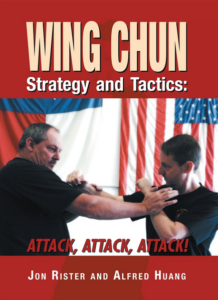For today’s interview we sat down with Sifu Jon Rister. He has written a number of books on Wing Chun and has trained under well known teachers like Sifu Franics Fong and Guro Dan Inosanto.
He was nice enough to let us pick his brain about Wing Chun training and the books he wrote.
Let’s see what he had to say!
Can you quickly tell us about your martial arts background?
In 1985, I started training under a student of Dan Inosanto. Then in 1986, I began training under Guro Dan ,and Sifu Francis Fong, Muay Thai with Ajarn Surachai Sirirsute (master Cha,i) and JKD with Larry B. Hartsell. Around 1999, I started to focus mainly on Wing Chun, Kali, and JKD.
How does your style of training/teaching different than other Sifu’s?
The main thing for me is teaching the survival skill while maintaining the traditional aspects for self-perfection (i.e. the internal qualities of the arts). While we train all the traditional drills and skill development exercises, we also commit a certain amount of time to practical combat skills (not training squared off and not by the numbers). I make the students move the fight, press the attack, and change positions continually so as to prevent attack from the rear or the sides, as Wing Chun should be done.
How does modern training compare to when you first started?
Well I can tell you this; it is not so much a matter of “modern training,” but rather the  “modern student.” The modern student averages 2 classes per week. This drives the training to a new place, forcing me to teach much differently than even ten years ago. I have students who have trained with me for 20 years and they always comment about the new students habits. I have to remind them, “Hey, you were able to train 5 days a week, 3 hours a day back in those days.” So the main thing I think in modern times is the student’s willingness (ability) to commit time to the art. That being said we have a lot better equipment and access to a vast amount of knowledge from the Internet (both good and bad).
“modern student.” The modern student averages 2 classes per week. This drives the training to a new place, forcing me to teach much differently than even ten years ago. I have students who have trained with me for 20 years and they always comment about the new students habits. I have to remind them, “Hey, you were able to train 5 days a week, 3 hours a day back in those days.” So the main thing I think in modern times is the student’s willingness (ability) to commit time to the art. That being said we have a lot better equipment and access to a vast amount of knowledge from the Internet (both good and bad).
What would your advice be to newer Wing Chun practitioners who are “up and coming”? For example, people who are new to the art.
Be mindful at all times in training, especially when doing forms. DO NOT just complete the sequence of actions. Place yourself at the center of each motion. Be in the moment and derive from that motion what is intended. Also, make every moment with another student count. Train to get the best from them and the best from you. Also remember who you are, and don’t forget Wing Chun is about you, not your teacher.
Since you have written a few books, which one of your books would you recommend someone start with?
Because of the need for the student to be effective sooner rather than later, I would recommend the Close Combat Strategies and Tactics book first.
It is all Wing Chun. The reason is that if you don’t live through this day, you won’t learn the art properly. Your mindset and attitude are far more valuable than any systemized collection of moves. Sure, one needs to study the art and learn the method and system thoroughly. But dispense it when you fight.
Then read Wing Chun Strategies and Tactics: Attack Attack Attack next. It will form your foundation and understanding of the art, without which, the art is merely a sideshow.
The second book, Wing Chun Strategies and Tactics II: Strike, Control, Break, is recommended to learn the base set of close combat tactics for each of the twelve gates.
From there, you can begin to learn how to use the weapons, which will teach you the pathways to the body and how to make the techniques work.
Sifu/Guro Jon Rister
President Rister Martial Arts
Instructor JF/JKDGA
Instructor Wing Chun USA
Instructor Inosanto Association
Phone (972)-768-2721
1119 Luke St #113
Irving,Texas 75061
